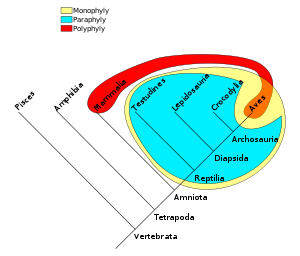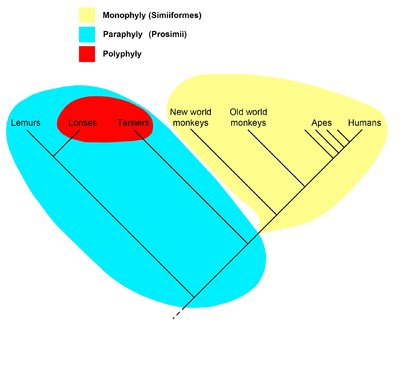Polyphyly

A polyphyletic (Greek for "of many races") group is characterized by one or more homoplasies: phenotypes which have converged or reverted so as to appear to be the same but which have not been inherited from common ancestors. Alternatively, polyphyletic is used to describe multiple ancestral sources regardless of convergence.
For example, warm-bloodedness evolved separately in the ancestors of mammals and the ancestors of birds. Other polyphyletic groups are protozoans, lipotyphla, and algae, as well as invertebrates.
Many biologists aim to avoid homoplasies in grouping species together and therefore it is frequently a goal to eliminate groups that are found to be polyphyletic. This is often the stimulus for major revisions of the classification schemes.
Researchers concerned more with ecology than with systematics may take polyphyletic groups as legitimate subject matter; the similarities in activity within the fungus group Alternaria, for example, can lead researchers to regard the group as a valid genus while acknowledging its polyphyly.[1]
Avoidance
In many schools of taxonomy, the existence of polyphyletic groups in a classification is discouraged. Monophyletic groups (that is, clades) are considered by these schools of thought to be the most important grouping of organisms.
One reason for this view is that some clades are simple to define in purely phylogenetic terms without reference to clades previously introduced: a node-based clade definition, for example, could be "All descendants of the last common ancestor of species X and Y". On the other hand, polyphyletic groups can often be delimited in terms of clades, for example "the flying vertebrates consist of the bat, bird, and pterosaur clades". Because polyphyletic groups can frequently be defined as a sum of clades, they are usually considered less fundamental than monophyletic (single, whole) clades.
A stronger reason is that grouping species monophyletically facilitates prediction far more than does polyphyletic grouping. For example, classifying a newly discovered grass in the monophyletic family Poaceae, the true grasses, immediately results in numerous predictions about its structure and its developmental and reproductive characteristics, inherited from the common ancestor of this family. In contrast, Linnaeus' assignment of plants with two stamens to the polyphyletic class Diandria, while practical for identification, turns out to be useless for prediction, since the presence of exactly two stamens has developed convergently in many groups.[2] Predictive success is the touchstone by which theories are evaluated in all experimental sciences.
Polyphyletic species
Species have a special status in systematics as being an observable feature of nature itself and as the basic unit of classification.[3] It is usually implicitly assumed that species are monophyletic (or at least paraphyletic). However hybrid speciation arguably leads to polyphyletic species.[4] Hybrid species are a common phenomenon in nature, particularly in plants where polyploidy allows for rapid speciation.[5]
See also
Notes
- ↑ Aschehoug, Erik T.; Metlen, Kerry L.; Callaway, Ragan M.; Newcombe, George (2012). "Fungal endophytes directly increase the competitive effects of an invasive forb" (PDF). Ecology. 93 (1): 3–8. doi:10.1890/11-1347.1. Retrieved July 8, 2013.
- ↑ Stace, Clive A. (2010). "Classification by molecules: What's in it for field botanists?" (PDF). Watsonia. 28: 103–122. Retrieved July 31, 2013.
- ↑ Queiroz, Kevin; Donoghue, Michael J. (December 1988). "Phylogenetic Systematics and the Species Problem". Cladistics. 4 (4): 317–338. doi:10.1111/j.1096-0031.1988.tb00518.x. Retrieved 21 January 2015.
- ↑ Hörandl, E.; Stuessy, T.F. (2010). "Paraphyletic groups as natural units of biological classification". Taxon. 59 (6): 1641–1653.
- ↑ Linder, C.R.; Risenberg, L.H. (22 June 2004). "Reconstructing patterns of reticulate evolution in plants". American Journal of Botany. 91 (10): 1700–1708. doi:10.3732/ajb.91.10.1700. Retrieved 14 December 2011.
References
- Tudge, Colin (2000). The Variety of Life. Oxford University Press. ISBN 0198604262.
External links
- Funk, D. J., and Omland, K. E. (2003). "Species-level paraphyly and polyphyly: Frequency, cause and consequences, with insights from animal mitochondrial DNA" Annu. Rev. Ecol. Evol. Syst. 34: 397–423. at ftp://137.110.142.4/users/bhhanser/Subspecies%20general%20literature/FunkEtal2003AnnuRevEcolEvolV34pp397-423.pdf
